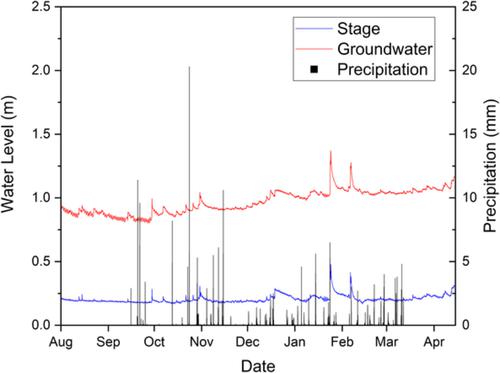当前位置:
X-MOL 学术
›
Hydrol. Process.
›
论文详情
Our official English website, www.x-mol.net, welcomes your feedback! (Note: you will need to create a separate account there.)
Rainfall, runoff and shallow groundwater response in a mixed-use, agro-forested watershed of the northeast, USA
Hydrological Processes ( IF 3.2 ) Pub Date : 2021-07-16 , DOI: 10.1002/hyp.14312 Kaylyn S. Gootman 1 , Jason A. Hubbart 1, 2
Hydrological Processes ( IF 3.2 ) Pub Date : 2021-07-16 , DOI: 10.1002/hyp.14312 Kaylyn S. Gootman 1 , Jason A. Hubbart 1, 2
Affiliation

|
Stream and shallow groundwater responses to rainfall are characterized by high spatial variability, but hydrologic response variability across small, agro-forested sub-catchments remains poorly understood. Conceivably, improved understanding in this regard will result in agricultural practices that more effectively limit nutrient runoff, erosion, and pollutant transport. Terrestrial hydrologic response approaches can provide valuable information on stream-aquifer connectivity in these mixed-use watersheds. A study was implemented, including eight stream and co-located shallow groundwater monitoring sites, in a small sub-catchment of the Chesapeake Bay watershed in the Northeast, USA to advance this ongoing need. During the study period, 100 precipitation-receiving days (i.e., 24-hour periods, midnight to midnight) were observed. On average, the groundwater table responded more to precipitation than stream stage (level change of 0.03 vs. 0.01 m and rainfall-normalized level change estimate of 3.81 vs. 3.37). Median stream stage responses, groundwater table responses, and response ratios were significantly different between sub-catchments (n = 8; p < 0.001). Study area average precipitation thresholds for runoff and shallow groundwater flow were 2.8 and 0.6 cm, respectively. Individual sub-catchment thresholds ranged from 0.5 to 2.8 cm for runoff and 0.2 to 1.3 cm for shallow groundwater flow. Normalized response lag times between the stream and shallow groundwater ranged from −0.50 to 3.90 s·cm−1, indicating that stormflow in one stream section was regulated by groundwater flow during the period of study. The observed differences in hydrologic responses to precipitation advance future modelling efforts by providing examples of how terrestrial groundwater response methods can be used to investigate sub-catchment spatial variability in stream-aquifer gradients with co-located shallow groundwater and stream stage data. Additionally, results demonstrate asynchronous stream and shallow groundwater responses on precipitation-receiving days, which may hold important implications for modelling hydrologic and biogeochemical fate and transport processes in small, agro-forested catchments.
中文翻译:

美国东北部混合用途的农林流域的降雨、径流和浅层地下水响应
河流和浅层地下水对降雨的响应具有高度的空间变异性,但对小型农林子集水区的水文响应变异性仍知之甚少。可以想象,在这方面的更好理解将导致更有效地限制养分流失、侵蚀和污染物迁移的农业实践。陆地水文响应方法可以提供有关这些混合用途流域中河流-含水层连通性的宝贵信息。在美国东北部切萨皮克湾流域的一个小子流域中实施了一项研究,包括八个河流和共同定位的浅层地下水监测站点,以推进这一持续的需求。在研究期间,观察到 100 个降水日(即 24 小时周期,午夜至午夜)。一般,地下水位对降水的响应大于河流阶段(水位变化为 0.03 对 0.01 m,降雨标准化水位变化估计为 3.81 对 3.37)。子流域之间的中值河流阶段响应、地下水位响应和响应比率显着不同(n = 8; p < 0.001)。研究区径流和浅层地下水流的平均降水阈值分别为 2.8 和 0.6 厘米。个别子流域阈值范围为 0.5 至 2.8 厘米(径流)和 0.2 至 1.3 厘米(浅层地下水流)。河流和浅层地下水之间的归一化响应滞后时间范围为 -0.50 到 3.90 s·cm -1,表明在研究期间,一个河段的暴雨流量受到地下水流量的调节。观察到的降水水文响应差异通过提供示例说明如何使用陆地地下水响应方法来研究流-含水层梯度的子流域空间变异性,以及共同定位的浅层地下水和河流阶段数据,从而推进了未来的建模工作。此外,结果表明在降水接收日的异步河流和浅层地下水响应,这可能对模拟小型农林集水区的水文和生物地球化学归宿和运输过程具有重要意义。
更新日期:2021-08-07
中文翻译:

美国东北部混合用途的农林流域的降雨、径流和浅层地下水响应
河流和浅层地下水对降雨的响应具有高度的空间变异性,但对小型农林子集水区的水文响应变异性仍知之甚少。可以想象,在这方面的更好理解将导致更有效地限制养分流失、侵蚀和污染物迁移的农业实践。陆地水文响应方法可以提供有关这些混合用途流域中河流-含水层连通性的宝贵信息。在美国东北部切萨皮克湾流域的一个小子流域中实施了一项研究,包括八个河流和共同定位的浅层地下水监测站点,以推进这一持续的需求。在研究期间,观察到 100 个降水日(即 24 小时周期,午夜至午夜)。一般,地下水位对降水的响应大于河流阶段(水位变化为 0.03 对 0.01 m,降雨标准化水位变化估计为 3.81 对 3.37)。子流域之间的中值河流阶段响应、地下水位响应和响应比率显着不同(n = 8; p < 0.001)。研究区径流和浅层地下水流的平均降水阈值分别为 2.8 和 0.6 厘米。个别子流域阈值范围为 0.5 至 2.8 厘米(径流)和 0.2 至 1.3 厘米(浅层地下水流)。河流和浅层地下水之间的归一化响应滞后时间范围为 -0.50 到 3.90 s·cm -1,表明在研究期间,一个河段的暴雨流量受到地下水流量的调节。观察到的降水水文响应差异通过提供示例说明如何使用陆地地下水响应方法来研究流-含水层梯度的子流域空间变异性,以及共同定位的浅层地下水和河流阶段数据,从而推进了未来的建模工作。此外,结果表明在降水接收日的异步河流和浅层地下水响应,这可能对模拟小型农林集水区的水文和生物地球化学归宿和运输过程具有重要意义。



























 京公网安备 11010802027423号
京公网安备 11010802027423号